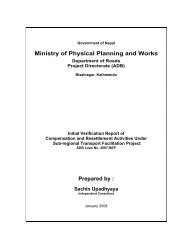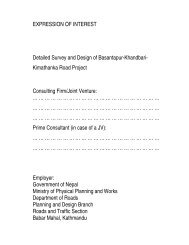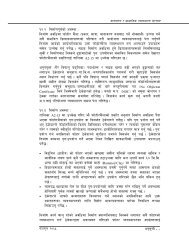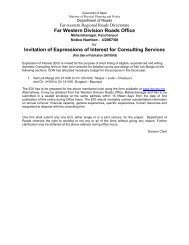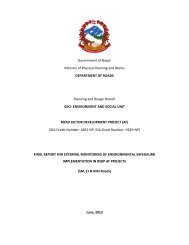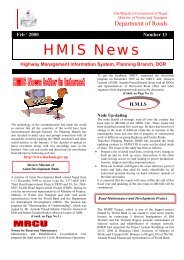NEPAL VEHICLE OPERATING COSTS - About Department of Road
NEPAL VEHICLE OPERATING COSTS - About Department of Road
NEPAL VEHICLE OPERATING COSTS - About Department of Road
Create successful ePaper yourself
Turn your PDF publications into a flip-book with our unique Google optimized e-Paper software.
Working Paper – Vehicle Operating Costs Page 12<br />
7. RECOMMENDED <strong>VEHICLE</strong> <strong>OPERATING</strong> COST EQUATIONS<br />
In view <strong>of</strong> the fact that Nepal uses Indian trucks and buses and the close similarities<br />
between the two countries it is recommended that Indian VOC model relationships<br />
should be the basis <strong>of</strong> a VOC model for Nepal. In the following Section a set <strong>of</strong><br />
recommended VOC relationships are identified for Nepal. The key relationships have<br />
been developed from the following reports:<br />
A Chesher & R Harrison: HDM Vehicle Operating Costs Evidence From Developing<br />
Countries The World Bank 1987, Washington DC.<br />
T Watanatada et al. The Highway Design and Maintenance Standards Model Volume 1.<br />
Description <strong>of</strong> the HDM III Model, The World Bank 1987, Washington DC.<br />
Central <strong>Road</strong> Research Institute: <strong>Road</strong> User Cost Study In India, Final Report. CRRI,<br />
1982, New Delhi<br />
The treatment <strong>of</strong> capital costs, crew and overheads is based on the approach used in the<br />
TRL road planning model RTIM3. Cars are assumed to drive a constant distance per<br />
year irrespective <strong>of</strong> speed. Other vehicles are assumed to increase the utilisation with<br />
speed by assuming constant working hours per year (including loading, unloading,<br />
refuelling etc). Expected working life is also assumed to be constant. To correctly<br />
calculate costs per kilometre with changes in vehicle speeds it is necessary to estimate<br />
and include in these calculations non-travelling working time per trip.<br />
In the fuel consumption equations an adjustment factor <strong>of</strong> 1.5 (rather than the figure <strong>of</strong><br />
1.15 mentioned earlier) has been included.<br />
Suggested modifications compared with 1994<br />
The following modifications are suggested for incorporation into the Nepal VOC model<br />
a) Vehicle capital costs have been modified by the subtraction <strong>of</strong> half the value<br />
<strong>of</strong> tyres (on the road)<br />
b) The cars and utility tyre consumption has been modified so that now the<br />
relationship reaches a plateau with increasing roughness. In the previous<br />
model tyre consumption reached a maximum and declined even to give<br />
negative values for very high roughness values.<br />
c) The interest charge formula has been improved to produce a more accurate<br />
result. Although interest is a monetary phenomena the equivalent <strong>of</strong> interest<br />
charges are required when discounting in a economic context.<br />
d) For trucks and buses oil consumption has been reduced by the multiplication<br />
<strong>of</strong> a factor <strong>of</strong> “0.54”<br />
e) Tyre consumption has been increased by multiplying by a factor <strong>of</strong> “1.34”.<br />
f) Fuel consumption has been modified by multiplying the basic equation by<br />
1.15 (the original recommended factor) and including an additional constant<br />
factor.


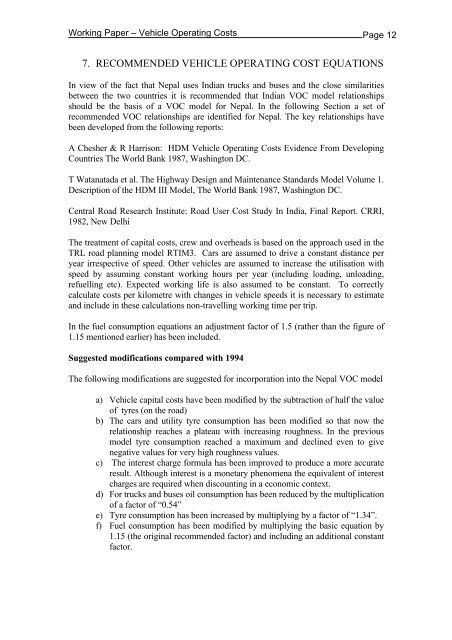
![j:6 ]zg cfof ]hgf](https://img.yumpu.com/51286794/1/190x245/j6-zg-cfof-hgf.jpg?quality=85)

![x'nfsL /fhdfu { cfof ]hgf](https://img.yumpu.com/50581959/1/190x245/xnfsl-fhdfu-cfof-hgf.jpg?quality=85)

